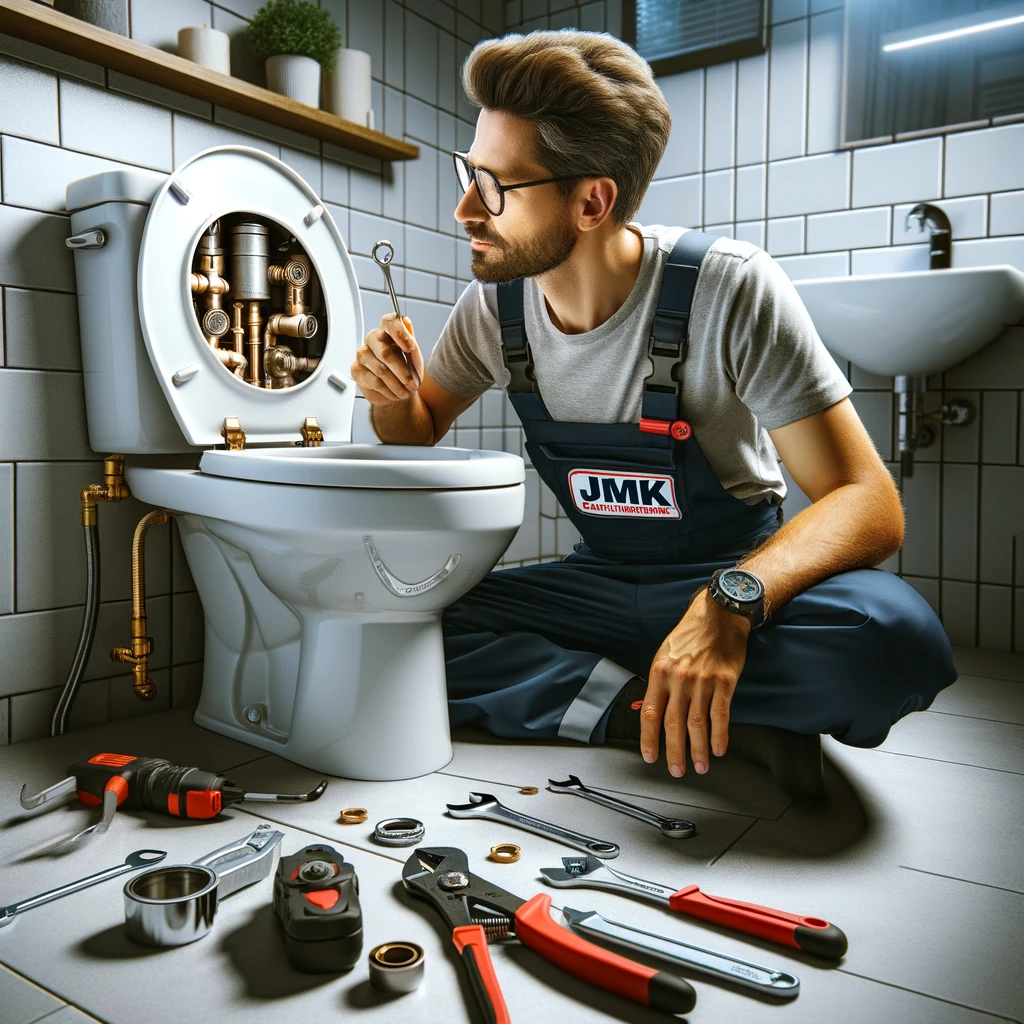Toilet Problems: A DIY Guide from JMK Plumbing

Toilets are an essential part of our daily lives, and when they malfunction, it can disrupt our routine and comfort. At JMK Plumbing, we understand the urgency of resolving toilet issues promptly. While some problems may require professional help, many common toilet issues can be fixed with a bit of DIY effort. In this guide, we’ll walk you through solutions to some of the most frequent toilet troubles, ensuring you’re prepared to handle them confidently.
Key Takeaways
- Fix Running Toilets: Inspect and replace the flapper or adjust the fill valve.
- Clear Clogs: Use a plunger or an auger for stubborn blockages.
- Boost Weak Flushes: Clean rim feed holes to improve flush strength.
- Address Leaks: Identify leak sources and fix with appropriate measures.
- Solve Phantom Flushes: Perform a dye test and replace the flapper if needed.
- Preventive Maintenance: Regularly check components and avoid chemical cleaners.
- Flush Wisely: Educate on what not to flush to prevent clogs.
- Professional Help: Seek expert assistance for unresolved issues.
The Running Toilet: A Persistent Nuisance
A running toilet can be more than just an annoyance; it can lead to significant water wastage and increased bills. Typically, this issue is caused by a faulty flapper or a problem with the fill valve. To diagnose and solve this:
- Check the Flapper: Remove the tank lid and inspect the flapper. If it’s not sealing properly, water will continue to flow from the tank into the bowl. A worn or warped flapper needs replacement.
- Adjust the Fill Valve: If the water level in the tank is too high and spills into the overflow tube, you’ll need to adjust the fill valve. Turn the adjustment screw clockwise to lower the water level.
Clogs: The Dreaded Blockage
Clogs can range from minor nuisances to major blockages that prevent flushing. Before you call in the pros, here are a couple of methods to try:
- The Plunger: A good old-fashioned plunger is often your best bet. Ensure you have a good seal around the drain before pumping vigorously.
- Auger Use: For more stubborn clogs, a toilet auger can reach deeper into the drain. Insert the auger into the bowl and crank the handle until you feel resistance, then push and pull to break up the clog.
Weak Flush: Lack of Power
When your toilet’s flush seems weak or sluggish, it’s usually due to clogged holes under the rim of the bowl. Here’s how to fix it:
- Clean the Rim: Using a small mirror, check the rim feed holes for any clogs. A piece of wire or a small brush can clear these obstructions, improving flush power.
Toilet Leaks: Spotting and Fixing
Leaks can occur in several places, from the base of the toilet to the connection between the tank and bowl. Identifying the source is crucial:
- Base Leaks: If water appears around the base after flushing, the wax seal might need replacing. This job can be more complex and might require a plumber.
- Tank Leaks: Leaks between the tank and bowl are often due to loose bolts or a deteriorated gasket. Tightening the bolts or replacing the gasket can usually fix this issue.
Phantom Flushes: The Ghost in the Machine
Sometimes, a toilet may randomly begin to refill, as though it was flushed. This phenomenon, known as a “phantom flush,” is typically caused by a very slow leak from the tank into the bowl:
- Diagnose the Leak: A dye test with food coloring can confirm this. Add a few drops to the tank water and wait. If color appears in the bowl without flushing, you have a leak.
- Replace the Flapper: As with running toilets, replacing a faulty flapper is often the solution.
Prevention: The Best Medicine
Regular maintenance can prevent many common toilet issues. Here are a few tips:
- Inspect Internals Regularly: Twice a year, check the internal components of your toilet. Look for signs of wear or damage.
- Avoid Chemical Cleaners: Over-the-counter chemical cleaners can erode your toilet’s internal components. Opt for natural alternatives or manual cleaning methods.
- Mind What You Flush: Educate all household members about what can and cannot be flushed. Even “flushable” wipes can cause blockages.
When to Call the Professionals
While many toilet troubles are within the realm of DIY repairs, certain situations call for professional intervention. If you encounter persistent issues, leaks you can’t pinpoint, or if DIY methods don’t resolve the problem, it’s time to call JMK Plumbing. Our team of experienced professionals can diagnose and fix any toilet issue, ensuring your home’s plumbing system operates smoothly.
Conclusion
Toilet troubles can be a source of frustration, but with the right approach, many common problems are easily solvable. By understanding the basics of toilet mechanics and maintenance, you can keep your bathroom in top working order. Remember, JMK Plumbing is here to help with any plumbing issues, big or small. Whether you’re tackling a DIY fix or need our expert assistance, we’re just a call away.
This guide aims to strike a balance between informative and engaging, providing JMK Plumbing‘s audience with practical advice while positioning the company as a knowledgeable and accessible resource for their plumbing needs.